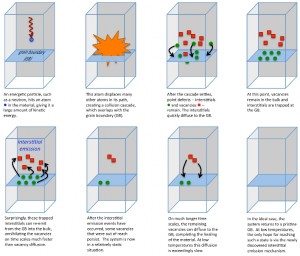Apr
8
Reactor Containment That Could Self Repair
April 8, 2010 | 3 Comments
Los Alamos researchers report a surprising mechanism that allows nanocrystalline materials to self repair themselves after suffering radiation-induced damage. Nanocrystalline materials are those created from nanosized particles, in the Los Alamos research, copper particles. A single nanosized particle – called a grain – is the size of a virus or even smaller. Nanocrystalline materials consist of a mixture of grains and the interface between those grains, called grain boundaries.
Nuclear reactor design or particularly, the materials that go into them, is one of the key challenges in finding materials that can withstand an outrageously extreme environment. In addition to constant bombardment by radiation, reactor materials may be subjected to extremes in temperature, physical stress, and corrosive conditions. Exposure to high radiation alone produces significant damage down to the nanoscale.

Self Repairing Nuclear Reactor Material Stages. Click on the image for the largest view. The captions are included.
Radiation can cause individual atoms or groups of atoms to be jarred out of place. Each vagrant atom becomes known as an “interstitial” a term often seen without explanation. The empty space left behind by the displaced atom is known as a “vacancy” and we don’t want vacancies in the containment vessels. Thus every interstitial created also creates one vacancy. As these defects of the interstitials and vacancies build up over time in a material, effects such as swelling, hardening or embrittlement can manifest in the material and lead to a catastrophic failure. Therefore, designing materials that can withstand radiation-induced damage is very important for improving the reliability, safety and lifespan of nuclear energy systems.
Because nanocrystalline materials contain a large fraction of grain boundaries that are thought to act as sinks that absorb and remove defects, scientists have expected that these materials should be more radiation tolerant than their larger-grain counterparts. Meanwhile, the ability to predict the performance of nanocrystalline materials in extreme environments has been severely lacking because specific details of what occurs within solids are very complex and difficult to visualize.
The Los Alamos researchers have begun to use computer simulations to help explain some of those details.
In a paper published in Science the Los Alamos researchers describe the never-before-observed phenomenon of a “loading-unloading” effect at grain boundaries in nanocrystalline materials. This loading-unloading effect allows for effective self-healing of radiation-induced defects. Using three different computer simulation methods, the researchers looked at the interaction between defects and grain boundaries on time scales ranging from picoseconds to microseconds (one-trillionth of a second to one-millionth of a second). The loading-unloading effect of grain boundaries might just be key to repairing irradiated metal while in place.
In the shorter timescales radiation-damaged materials underwent a “loading” process at the grain boundaries, in which the displaced interstitial atoms became trapped – or loaded – into the grain boundary. Under these conditions, the resulting number of accumulated vacancies in the bulk material occurred in amounts much greater than would have occurred in bulk materials in which a boundary didn’t exist. After trapping the interstitials, the grain boundary later “unloaded” the interstitials back into vacancies near the grain boundary. The process activity cancels both types of defects, so healing the material.
This unloading process was totally unexpected because grain boundaries traditionally have been regarded as places that accumulate interstitials, but not as places that release them. Although researchers found that some energy is required for this newly-discovered recombination method to operate, the amount of energy was much lower than the energies required to operate conventional mechanisms – providing an explanation and mechanism for enhanced self-healing of radiation-induced damage.
The new modeling systems of the “loading-unloading” role of grain boundaries helps explain previously observed counterintuitive behavior of irradiated nanocrystalline materials compared to their larger-grained counterparts. The insight provided by this work provides new avenues for further examination of the role of grain boundaries and engineered material interfaces in developing self-healing of radiation-induced defects. Such efforts could eventually assist or accelerate the design of highly radiation-tolerant materials for the next generation of nuclear energy applications.
The prospect that a containment vessel could self-repair as it’s bombarded is a fascinating idea. There should be follow up to test the reality of the computer simulations and physical testing to see the tolerance levels and recovery rates in real time. While many might assume that new reactor technologies would obviate the need for this development the reality might just take reactor lifetimes out much further.
We have a lot of actinides of an unpleasant nature to use, wear down and extract the energy within on the way to safe and utterly worthless waste. Self-healing materials in the reactors and the containment vessels can only help get the energy out and a result that can satisfy nearly everyone.
The Los Alamos press release listed the researchers in a group near the end, leaving no idea what concepts came from whom. But here they are: Xian-Ming Bai, Richard G. Hoagland and Blas P. Uberuaga of the Materials Science and Technology Division; Arthur F. Voter, of the Theoretical Division; and Michael Nastasi of the Materials Physics and Applications Division. Thanks folks, work worth doing.
Comments
3 Comments so far


Couldnt agree more with that, very attractive article
I was very encouraged to find this site. The reason being that this is such an informative post. I wanted to thank you for this special read of the subject. I ate every bit of it and I have you bookmarked to check out new stuff you post.
438926 455450Wow! This could be one particular of the most helpful blogs We